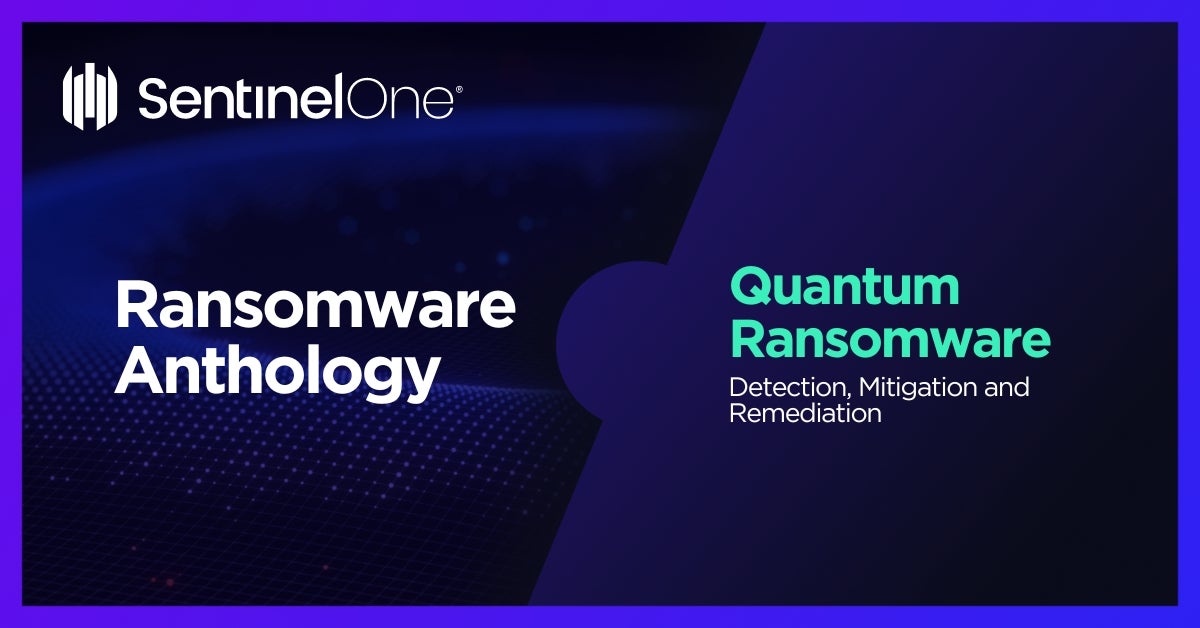Quantum Ransomware: In-Depth Analysis, Detection, Mitigation, and Removal
What Is Quantum Ransomware?
Quantum emerged in July of 2021. At that time, Quantum made their presence known on a TOR-based blog. However, the names of victims weren’t seen until October of the same year. On their blog, Quantum posts the names of victims and any leaked data, similar to other multi-pronged extortion groups. Compared to other ransomware, Quantum payloads lack certain features, such as disabling Volume Shadow Copies, and their campaigns are known to be incredibly fast, with detonation often occurring just hours after initial compromise.

What Does Quantum Ransomware Target?
Quantum ransomware targets organizations in a variety of industries, including healthcare, education, government, finance, transportation, and manufacturing.
Quantum Ransomware Technical Details
The Quantum group claims that they do not participate in the initial access of targeted environments, relying instead on IABs (Initial Access Brokers) or other methods of “obtaining access”.
Quantum ransomware can lack some features found in more modern ransomware. For example, many samples of Quantum do not interfere with or disable the Volume Snapshots feature.
Upon infection, victims are instructed to visit Quantum’s support site (TOR-based) to proceed with any of the attacker’s other demands.
Quantum ransomware is often a later-stage payload, with infection following an existing and thorough invasion of the target environment.
How to Detect Quantum Ransomware
- The SentinelOne Singularity XDR Platform can identify and stop any malicious activities and items related to Quantum.
In case you do not have SentinelOne deployed, detecting ransomware requires a combination of technical and operational measures designed to identify and flag suspicious activity on the network. This allows the organization to take appropriate action, and to prevent or mitigate the impact of the ransomware attack.
To mitigate the risk of this Ransomware without SentinelOne deployed, it is important to take a multi-layered approach, which includes the following steps:
- Use anti-malware software or other security tools capable of detecting and blocking known ransomware variants. These tools may use signatures, heuristics, or machine learning algorithms, to identify and block suspicious files or activities.
- Monitor network traffic and look for indicators of compromise, such as unusual network traffic patterns or communication with known command-and-control servers.
- Conduct regular security audits and assessments to identify network and system vulnerabilities and ensure that all security controls are in place and functioning properly.
- Educate and train employees on cybersecurity best practices, including identifying and reporting suspicious emails or other threats.
- Implement a robust backup and recovery plan to ensure that the organization has a copy of its data and can restore it in case of an attack.
How to Mitigate Quantum Ransomware
- The SentinelOne Singularity XDR Platform can return systems to their original state using either the Repair or Rollback feature.
In case you do not have SentinelOne deployed, detecting ransomware requires a combination of technical and operational measures designed to identify and flag suspicious activity on the network. This allows the organization to take appropriate action, and to prevent or mitigate the impact of the ransomware attack.
To better detect Quatum ransomware without SentinelOne deployed, it is important to take a multi-layered approach, which includes the following steps:
- Use anti-malware software or other security tools capable of detecting and blocking known ransomware variants. These tools may use signatures, heuristics, or machine learning algorithms, to identify and block suspicious files or activities.
- Monitor network traffic and look for indicators of compromise, such as unusual network traffic patterns or communication with known command-and-control servers.
- Conduct regular security audits and assessments to identify network and system vulnerabilities and ensure that all security controls are in place and functioning properly.
- Educate and train employees on cybersecurity best practices, including identifying and reporting suspicious emails or other threats.
- Implement a robust backup and recovery plan to ensure that the organization has a copy of its data and can restore it in case of an attack.
How to Mitigate Quantum Ransomware
- The SentinelOne Singularity XDR Platform can return systems to their original state using either the Repair or Rollback feature.
If you do not have SentinelOne deployed, there are several steps that organizations can take to mitigate the risk of Quantum ransomware attacks.
Educate Employees
Employees should be educated on the risks of ransomware, and on how to identify and avoid phishing emails, malicious attachments, and other threats. They should be encouraged to report suspicious emails or attachments, and to avoid opening them, or clicking on links or buttons in them.
Implement Strong Passwords
Organizations should implement strong, unique passwords for all user accounts, and should regularly update and rotate these passwords. Passwords should be at least 8 characters long, and should include a combination of uppercase and lowercase letters, numbers, and special characters.
Enable Multi-factor Authentication
Organizations should enable multi-factor authentication (MFA) for all user accounts, to provide an additional layer of security. This can be done through the use of mobile apps, such as Google Authenticator or Microsoft Authenticator, or through the use of physical tokens or smart cards.
Update and Patch Systems
Organizations should regularly update and patch their systems, to fix any known vulnerabilities, and to prevent attackers from exploiting them. This includes updating the operating system, applications, and firmware on all devices, as well as disabling any unnecessary or unused services or protocols.
Implement Backup and Disaster Recovery
Organizations should implement regular backup and disaster recovery (BDR) processes, to ensure that they can recover from ransomware attacks, or other disasters. This includes creating regular backups of all data and systems, and storing these backups in a secure, offsite location.
The backups should be tested regularly, to ensure that they are working, and that they can be restored quickly and easily.